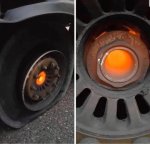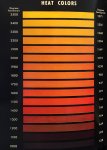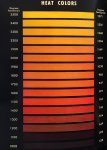rothfm
Ensign
- Joined
- Sep 26, 2006
- Messages
- 913
Seems that little fold-over "tang" style retainer, or cotter pin/Castle nut cover is just rediculous. Someone correct me if I'm wrong please.
1st Been boating and trailering for 25 years. Have kept my gear in top notch shape. In fact I spend more time every spring/fall in my trailer than my boat! Replace everything every couple years tires included. All new.
However I now Slip my boat partially because of 2 seperate episodes over the last few years. Near disasters with the entire wheel and hub leaving the trailer at highway speed, bouncing over cars behind me.
1st Trailer had the captive castle nut cover with cotter style pin. I just took apart my current Venture 9300 LB Tandem form normal maintenance, and it baffles me how these can possibly stay on, if there was a bearing failure.
If the bearing tears up, and the race comes outward, spinning against any of that front hardware ( captive castle cover, cotter pin, Tang", The nut will eventually turn free, or just get ground down until the wheel and hub can freely come off.
Right??
I just finished checking and repacking my big Venture, and Dam, those little fold-Over "Tangs" are the only thing holding the wheel on.
This has happened twice and and I'm obsessed with proper maintenance, and checking digilently. But holy cow, I'm looking at this setup, not much to hold anything together if they bearings tear up. Seems like such crappy designs.
Decided, amoung other reasons too, to slip my boat finally and love it. Just need 1 trip home soon with the trailer.
Maybe I'm seeing this wrong? Thoughts?
Thanks
1st Been boating and trailering for 25 years. Have kept my gear in top notch shape. In fact I spend more time every spring/fall in my trailer than my boat! Replace everything every couple years tires included. All new.
However I now Slip my boat partially because of 2 seperate episodes over the last few years. Near disasters with the entire wheel and hub leaving the trailer at highway speed, bouncing over cars behind me.
1st Trailer had the captive castle nut cover with cotter style pin. I just took apart my current Venture 9300 LB Tandem form normal maintenance, and it baffles me how these can possibly stay on, if there was a bearing failure.
If the bearing tears up, and the race comes outward, spinning against any of that front hardware ( captive castle cover, cotter pin, Tang", The nut will eventually turn free, or just get ground down until the wheel and hub can freely come off.
Right??
I just finished checking and repacking my big Venture, and Dam, those little fold-Over "Tangs" are the only thing holding the wheel on.
This has happened twice and and I'm obsessed with proper maintenance, and checking digilently. But holy cow, I'm looking at this setup, not much to hold anything together if they bearings tear up. Seems like such crappy designs.
Decided, amoung other reasons too, to slip my boat finally and love it. Just need 1 trip home soon with the trailer.
Maybe I'm seeing this wrong? Thoughts?
Thanks























